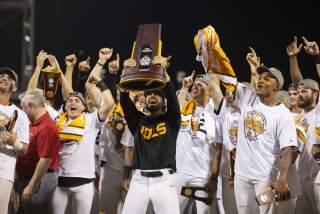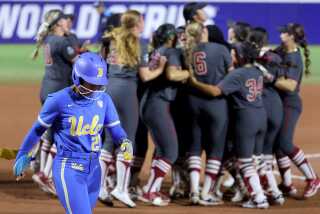It’s Mutual About OMAHA
- Share via
OMAHA — Florida Marlin outfielder Mark Kotsay recalls how, during his college days, he and his Cal State Fullerton teammates would dream of a special place.
When Kotsay, the most outstanding player of the 1995 College World Series, dressed for a game or drove around town, he often listened to a song by the Counting Crows called “Omaha.”
“It was our theme song,” Kotsay said from Miami. “We would listen to it and think about going to Omaha. Every college team thinks about it. That’s why you play all year long--to get to Omaha.”
The song wasn’t about baseball, but that didn’t matter to the Fullerton players who won the NCAA title that year.
Mention “Augusta,” and golfers visualize the Masters. Say “Churchill Downs,” and horse racing comes to mind. “Indianapolis” is synonymous with auto racing.
And “Omaha” means the College World Series--as the NCAA championship tournament has come to be called.
“Most of us in the baseball world do not refer to it as the College World Series,” said Jerry Kindall, the former Arizona coach whose teams won two national titles. “We just say ‘Omaha’ and that encompasses all of the thrill of winning in college baseball.”
Kindall pauses and then says it again: “Omaha.”
The College World Series started in Kalamazoo, Mich., in 1947 and 1948, then moved for one year to Wichita, Kan. Ever since, Omaha has been the host of college baseball’s showcase event.
Dennis Poppe, director of championships for the NCAA, said the University of Georgia has held the men’s tennis championships 19 of the last 23 years, and the Division II football title has spent 14 years in Florence, Ala.
That’s small beans compared with Omaha. From June 11-19, the College World Series celebrates its 50th year at Rosenblatt Stadium.
In today’s era of corporate-sponsored bowl games and competitive bidding for the Final Four, no other college championship event comes close to such a long-term fit with the same host city.
“For many other venues, we’re in and we’re out,” Poppe said.
So what makes Omaha different?
“A commitment by the community to support the tournament regardless of the teams involved,” Poppe said. “Omaha has taken pride and ownership in this event. The people have taken extra steps to make it part of their community and it has become part of their culture.”
Poppe said other cities have expressed interest in staging the College World Series but no bids have come in. He said potential hosts know what’s involved and recognize Omaha’s 50-year tradition.
“I’ve had people say, ‘If Omaha ever gives it up, let us know,’ ” he said. “It’s out of respect for the city--like when two people are up for a job and one won’t apply because of great respect for the other.”
Omaha has shown no signs of letting go. Negotiations are continuing on a contract extension that would keep the series through 2005 with an option to add another five years after that.
City officials said last year’s CWS brought in $11.4 million in direct spending with an overall economic impact of $29 million. But the partnership between the town and the event is about more than money.
Kotsay said he’ll always remember the interaction between fans and players in Omaha, especially at the pre-series autograph day. And he said civic groups went out of their way to accommodate his team and family.
That’s how Jack Diesing Jr. wants players to feel.
“We make sure the buses are there to pick up the teams at the airport,” said Diesing, president of College World Series Inc., the organizational arm that promotes the event and works with the NCAA to keep it.
“We get their checks cashed. We sew the College World Series logo on their uniforms. We do all the little things to make them feel at home,” Diesing said.
Kindall, who played on the Minnesota team that won the College World Series in 1956, said he has no bad memories from his six trips to Omaha as a player and coach.
“The grounds, the dugouts, the press box, the sight lines--everything is done to create the best possible setting for players and spectators,” he said. “What more could college baseball ask than what Omaha has produced?”
In return, fans have been treated to a half-century of budding stars.
They’ve seen Dave Winfield (Minnesota, 1973), Roger Clemens (Texas, 1982-83), Barry Bonds (Arizona State, 1983-84), Albert Belle (Louisiana State, 1986), and Nomar Garciaparra (Georgia Tech, 1994), to name a few.
And they’ve flocked to the 22,700-seat ballpark in record numbers in recent years. Last year’s total attendance of 204,361 was a record, and the crowd of 24,456 for the championship contest set a single-game mark.
Win or lose, the players leave with an unforgettable experience.
“Even in professional baseball, the College World Series is still a big deal,” Kotsay said. “Guys who played in Omaha will swap stories. Even guys who never played in Omaha will come up and ask me what it was like to be in the College World Series.”
More to Read
Go beyond the scoreboard
Get the latest on L.A.'s teams in the daily Sports Report newsletter.
You may occasionally receive promotional content from the Los Angeles Times.










